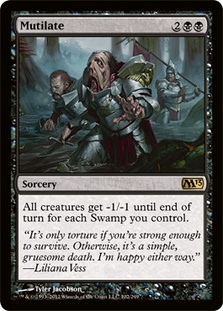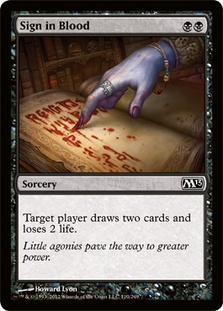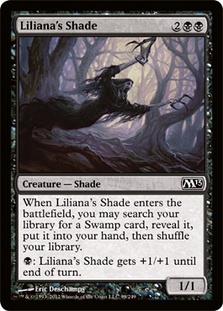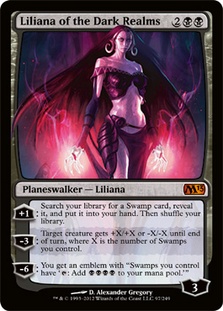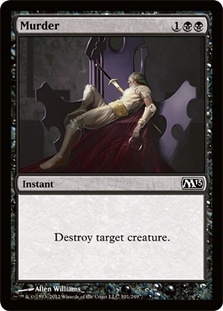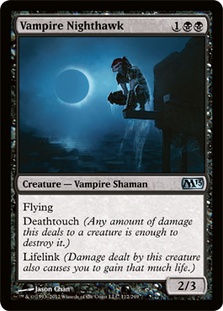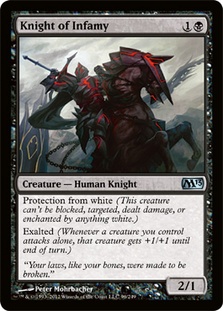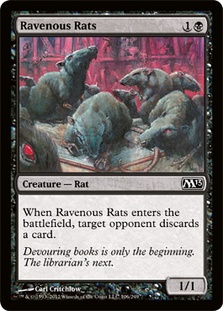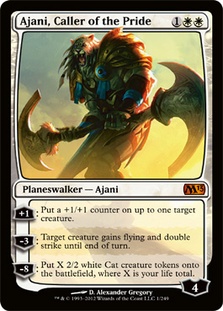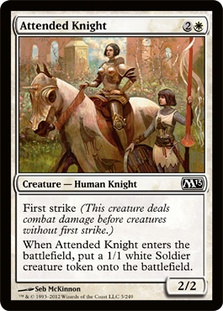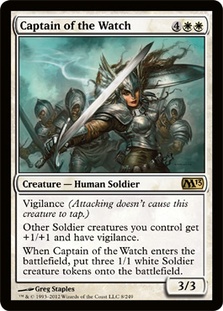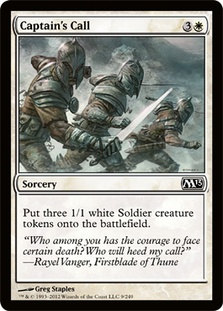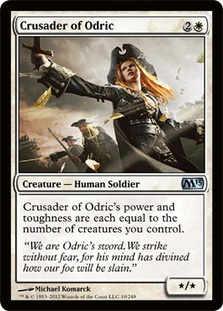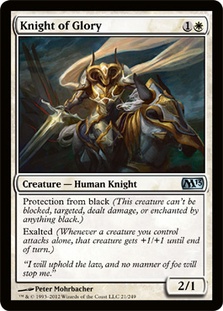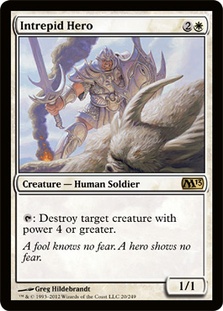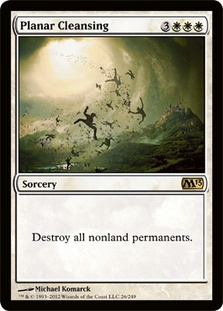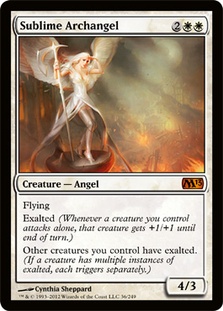If we were WotC’s R&D, tasked with rotating the Titans out in M13, what would we do?
One of the keys to M13 was destined to be how Wizards handled replacing the Titan cycle. The M11 Titans, which were reprinted in full in M12, are among the most over the top and unbelievably powerful cycles of all-time. All five are so much better than cards are normally, but they were all sort of given a pass at the same time for two reasons:
1) By pushing all the sixes at the same time, there was some amount of balance from the fact that players can’t play all of them at once.
2) They were designed to be six-drops that were good in a world dominated by Jace, the Mind Sculptor (the world Wizards knew was coming when they designed them). That is a very, very high bar.
If Wizards could do it again, it sounds like they would have had only two Titans in M12, phasing them out (or possibly rotating them around a bit). Perhaps if only Inferno Titan and Frost Titan had been reprinted in M12, the sentiment would have been a little less extreme that people were ready to move on away from the Titans.
Still, it is not like the Titans have been the most dominant cards of the past two years. Caw-Blade generally didn’t use many Titans, if any. However, Titans contributed to the original dominance of Caw-Blade and now to the current popularity and success of Delver. Titans have been notorious for pushing out midrange decks, leaving us with aggro-control to try to tempo them out and hyper-aggro to try to kill people before Titans take over.
Of course, as we have seen, if enough of the field becomes aggro-control and aggro with Titans waning from the landscape anyway, midrange decks like Kibler’s Naya Pod deck end up coming out to play. Kibler’s deck is almost diabolical in how engineered it is to thrive in the world of Delver and decks that try to beat Delver. It is not the deck you’d want to play if we just showed the people from one year ago the card file and asked them to build decks.
Now that the Titans are in their final sprint (as well as Wurmcoil Engine and Consecrated Sphinx, the sixth and seventh Titans), the question is: what did Wizards of the Coast replaced them with? As serious players trying to predict and understand the future of tournament Magic, one of the strongest tools we can develop is the ability to make predictions based on our understanding of game design.
Believe it or not, R&D is not acting completely at random. They are not just rolling dice to determine every casting cost or set of stats. There is a method to their madness. Once we study that method, we can gain insight into what they were likely thinking when they designed each card. They aren’t going to know beforehand how good every single card is going to turn out to be. They are certainly going to make mistakes from time to time. However, understanding what they must have been thinking is the equivalent of a treasure map.
If we were WotC’s R&D, tasked with rotating Titans out in M13, what would we do?
For starters, we are going to need a new splashy mythic in every color. Rancor is incredible and exciting, but more of a replacement for Mana Leak than anything else. Nicol Bolas, Planeswalker being back is pretty epic, so it is very possible that he is supposed to fill that role for one of his colors (blue, as it turns out, only has two mythics…)
Next of all, we need to avoid a cycle. If we made five new cards in a straight cycle at mythic, it would be impossible to prevent constant comparisons to the Titans (a pretty unreasonable bar). To counter this, we need to rely on the age-old game design technique of creating incomparables. When game designers just make new items, new characters, and new abilities that have bigger numbers than the old ones, it is easy to compare them to the old ones and power creep sets in.
However, when game designers make new items, new characters, and new abilities that are different than old ones in incomparable ways, it is apples to oranges. This uncertainty, this unknown, lets many different items, characters, and abilities exist in the same world.
These five cards wouldn’t have to all be as powerful as Titans (in a vacuum), but we’d want to engineer the set so that all five have good homes to make sure people can feel like they are better than the old cards. To understand this, ask yourself what is a better card: Primeval Titan or Daybreak Ranger?
Primeval Titan is, by a lot, yet the majority of Kessig Wolf Run decks in Standard use the Ranger, not the Titan (G/R Aggro). Context is everything. So, if we can’t make five cards that are all better than Titans on raw power, we should at least design five cards that will get played over Titans in the right homes. One thing is for sure: if these five cards don’t find homes, we have missed the mark.
Once we switch back into tournament players trying to break the game mode, it is clear we want to figure out what those secret five cards are…
Monday, we covered red and blue here. Today, let’s tackle the black and white cards.
Black
Mutilate, Sign in Blood, Liliana’s Shade, Liliana of the Dark Realms: Let’s just get this party started.
Mono. Black. Control.
Look, I am not saying that Mono-Black Control is going to take over the format. I am also not saying that the only way to use these cards is Mono-Black Control. What I am saying is that these cards explicitly reward a Mono-Black player an awful lot and there are plenty of other great new tools like Duress, Vampire Nighthawk, Murder, Ravenous Rats, and more.
First of all, let’s talk about Mono-Black Control’s reputation. There are a percentage of people that don’t have a very long view on the game that are quick to condemn whatever archetypes haven’t been dominant recently as being intrinsically flawed, while whatever archetypes have been good recently are “naturally good.”
That is poppycock.
You think aggro-control has always been good? Please.
Consider Mono-Red Aggro, an archetype that is currently considered a joke and certainly not good. There have been many times where Mono-Red Aggro was one of the first decks people thought of as “always good in Magic,” which is ironic because it was also one of the first archetypes that people used as a joke to describe a really bad deck. In fact, the specific bad red aggro deck people would diss was Goblins, an archetype that eventually went on to completely dominate many formats.
So, what happened?
They printed new cards. Ramp may seem like it is just always awesome to people who have been playing less than three years, but really Primeval Titan is just overpowered. There really isn’t a ton of fast combo or prison these days, but those archetypes have dominated previous formats to a degree that people just assumed they were intrinsically better.
The secret? It’s all about the card file.
Mono-Black being regarded as intrinsically bad is particularly laughable. Am I the only one around here that remembers Necropotence decks?! That was like four years!
What’s that? Someone, somewhere is making the argument that Necropotence, the card, made that deck? Well, two things:
1) Mono-Black Control was very good when Torment came out (in no small part due to Mutilate). Vampires has succeeded as a Mono-Black deck. Suicide Black was a thing. Infect was a thing. Zombies is a thing. Yawgmoth’s Will lead to a rise of Mono-Black Control (with Urza’s Baubles, Corrupts, and Dark Ritual). Black aggro is often a common archetype, but Mono-Black Control is very much its own entity and has been successful in tons of formats many times.
2) Necropotence made the Necro decks? That is a single card, and that is the exact point! A single card can make absolutely any archetype. It just takes the right card. When a deck gets a couple new tools, the whole game can change. Just look at Strangleroot Geist and Huntmaster of the Fells or Gravecrawler and Geralf’s Messenger. Hell, those last two actually launched a new successful Mono-Black archetype this year.
What could you possibly ask for in a Mono-Black deck?
- Enough Swamps matters mechanics to reward you for staying Mono-Black.
- A top tier sweeper, like Nevinyrral’s Disk or Mutilate.
- Good answers to artifacts and enchantments, like Nevinyrral’s Disk or Ratchet Bomb.
- Good planeswalkers, like Liliana or Liliana.
- Ways to pay life to draw cards, like Skeletal Scrying or Sign in Blood.
- Good life gain to make up for it.
- Good creatures, like Phyrexian Obliterator or Bloodline Keeper, Wurmcoil Engine or Grave Titan.
- Good removal, like Go for the Throat, Doom Blade, Tragic Slip, Geth’s Verdict, Liliana of the Veil, Ratchet Bomb, and so much more.
- Some way to interact with the stack, like Duress or Despise (though Inquisition of Kozilek or Thoughtseize would be preferred).
- Great sideboard cards, like Curse of Death’s Hold or Nihil Spellbomb.
Of these, only with paying life for cards are we really coming up short (mostly), with life gain not really being super relevant as a result of the mild shortage of tier 1 Phyrexian Arena type effects (though we do have a few options). Additionally, our discard is fine but not great.
This doesn’t make the case for Mono-Black being good, this time. This does make the case that Mono-Black has been good many times; so we should approach it with an open mind when WotC prints so many overtly Mono-Black centric cards.
Mutilate
Looking at each of these cards specifically, let’s start with Mutilate. How good is Mutilate? It is freaking awesome. It is not as good as Damnation, but in a Mono-Black deck, it is much better than Black Sun’s Zenith (as it basically just costs two less mana for killing medium to big creatures). This is an excellent sweeper and a big incentive to play Mono-Black (at least until Shocklands get reprinted…)
Sign in Blood
Ok, how about Sign in Blood? This one isn’t exactly new. Night’s Whisper was awesome when it was first printed, appearing in everything from B/G to Mono-Black to U/B combo decks. Then Sign in Blood was printed and showed up in Vampires, Jund, Grixis, and more. Now that it is back, it is surely going to show up in the same sort of space.
It is nice to have a two-cost spell that can further your game plan without needing to commit a creature to the board. As a bonus, the ability to kill people with it is very underrated, particularly when you are at low life and can’t afford to use it on yourself. It is not that you are knocking your opponent from nine to seven. It is the spell you use to knock them from two to zero. Even a bad Shock is better than a dead card when you are at a low life total.
Why is drawing two cards for two mana and two life good? Is Sign in Blood so insane that everyone should be playing it? Well, I mean, it is basically in the same league as Divination (probably very slightly better), but there is so much tougher competition for blue card draw than black. Black appreciates it more.
Liliana’s Shade
How about Liliana’s Shade? Liliana’s Shade is tricky to evaluate for the exact reasons that Mutilate and Sign in Blood are not. They have both been proven winners many times. Liliana’s Shade is a cross between a Shade (which has only been good with Nantuko Shade, which isn’t even that good anymore… Or is it?! If only it had been in M12 and not just M11…) and a cantrip that gives you a Swamp instead of a card (which has no successful historical precedent).
What is better, drawing a random card or a Swamp? Well, it depends of course, but attached to a four-mana creature I’d generally prefer the random card, but I wouldn’t kick a Swamp out of bed.
This makes Liliana’s Shade a Looming Shade that for just one mana more draws you an extra card. Drawing a card for a mana is a very, very good deal. However, a Swamp is not the same as a card and as is standard, Looming Shade stands underpowered by standard Standard standards, anyway.
Once we properly cost Looming Shade at two, we aren’t exactly impressed by the ability to draw a card that is slightly worse than a random card for another two mana. On rate, Looming Shade is probably a small notch below Phyrexian Rager. That said, he is a Shade, which Mono-Black is much more in the market for than a Grey Ogre. It is that he would be so contextually valuable that I think he has a chance at all.
What makes his life very tough is that Liliana of the Dark Realms, Phyrexian Obliterator, Bloodline Keeper, Lashwrithe, Entomber Exarch, and Skinrender all make very good claims to the four-spot, to say nothing of Solemn Simulacrum which might be a better Liliana’s Shade (if you don’t value the Shade ability super high).
Liliana of the Dark Realms
One of two brand new planeswalkers in the set, “Medium-Liliana” has been welcomed with passable but fairly lukewarm revues. This is probably due to a few factors:
- She is immediately following a very successful three-cost version that people understand better. Just think about how many people maintained for so long that little Jace was better than big Jace. People like things they understand (or feel like they understand).
- She suggests playing Mono-Black Control, an archetype that hasn’t been tier 1 recently despite how ravenously devoted of a following it has (which is evident every time a new set comes out).
- There is an unreasonably high bar for four-cost planeswalkers, and she is just not in the same league as Jace, Elspeth, or Ajani Vengeant (Thank God!). In fact, she is probably not in the same league as Tezzeret, Koth, or Sorin. She’s not bad, though…
First of all, she is a planeswalker. Right off the top, she has got to be at least in the discussion. Next, even if she is only for relatively niche decks, like Nissa Revane, she is a powerful weapon in those decks.
To evaluate her, let’s start with her minus ability. This is the one that scares everyone off. If you could use her as a removal spell immediately then keep her on one loyalty, she would be unreal. Since little Liliana did just that, it is hard for people to not think of what could have been. Here’s the thing: that thought process is so natural, I cannot imagine that R&D wouldn’t have thought of that. They would have tried it at those numbers, without question. This suggests it was pulled back, likely from being too strong. Any card that is that close to being too strong to print is interesting.
Anyway, as a four-cost removal spell, she isn’t amazing or anything, but she isn’t that bad. The thing is, that is only half of the ability. You can also Howl from Beyond your guy, which is particularly awesome on a Vampire Nighthawk, or if you want to get really filthy, on a Plague Stinger. In fact, Lashwrithing your Plague Stinger was the entire reason to play Infect. Liliana is not as good as Lashwrithe in such a deck, but it is more versatile and could certainly be numbers five and six in the deck.
So she can be a removal spell or a Howl from Beyond. What about that plus ability? Well, as we mention above, drawing a Swamp is worse than drawing a random card (at least in general when you have four mana in play). Still, it is not that far off.
Once we look at the sequence of:
Turn 4: Play Liliana of the Dark Realms and find a fifth Swamp.
Turn 5: Use Liliana to kill their biggest guy and keep her.
Turn 6: Use Liliana to find a sixth Swamp, then play Grave Titan or Wurmcoil Engine.
This is a pretty reasonable line, whatever we do with our mana on turn 5.
What about her ultimate? Ok, this one is pretty silly. Generally, that is at least 28 black mana a turn (often much more), which is enough to do just about any preposterous thing you can think of. The thing is, there isn’t even a drain life X spell to use. It would be pretty insane to Diabolic Revelation for 23 cards of your choice, however.
Speaking of which, Diabolic Revelation is a pretty hot card that seems so unwieldy but could actually surprise people. It is literally just two mana more than Blue Sun’s Zenith (at sorcery speed) to turn every card into a Demonic Tutor. Sure, you have to spend seven mana before you are “ahead,” but you didn’t really want to cast Blue Sun’s Zenith for less than six mana itself. The ability to Demonic Tutor for six mana isn’t great, but it is hardly the worst “downside” in the world since you can often go get a Mutilate or Grave Titan and catch back up next turn. Then the possible upside of being able to Tutor for multiple cards? That is actually pretty exciting…
Mimic Vat is an often-overlooked gem that works so well with our abundance of black removal, plus it solves hard problems (like Gravecrawler, Geralf’s Messenger, Strangleroot Geist, and Firewing Phoenix, and creatures with protection from black).
With such conditional discard it can be smart to mix it up, limiting the diminishing returns you get from drawing two of the same kind. It is not clear that this approach is actually better than using Mind Rots, but I generally like Despise at the moment.
As you can see, I actually really like Phyrexian Obliterator right now. If you play that turn 4, an awful lot of decks are just going to have a helluva time. Just imagine a G/R deck trying to fight through one!
I realize this looks like a lot of random one’s and two’s, but the same is always true with many kinds of control decks. Diminishing returns is a very real thing and having a variety of possible reactive cards gives us so much flexibility in combating our opponents.
A different possible approach to Mono-Black is to go back to the Infect-style of deckbuilding, taking advantage of new Liliana’s +X/+X ability:
Creatures (14)
Planeswalkers (2)
Lands (27)
Spells (17)

Cathedral of War is a super-hot new tool for mono-color decks that we will be discussing at greater length on Friday. It also happens to be particularly effective with infect (i.e., double strike).
Duress
As you can see from the Mono-Black list above, I think Duress is not just a sideboard card, as many people assume. I do think it will see a lot more play there, just as Negate does, but it can sneak into maindecks the same way the miser’s Negate shows up from time to time (particularly in formats where Mana Leak isn’t legal).It is really hard to justify playing much of this action, particularly when Despise is a bit more reliable, but it is so valuable to hit that Snag before you drop an Obliterator.
Distress is a cute middle ground, but drawing two Distresses can be pretty miserable. There is a classic weakness to these one-for-one discard spells that if your opponent just plays out all of their cards, they can be “worthless.” Mutilate gives black a great way to punish people that try to do just that.
Murder
Why am I not playing Murder in the deck above? After all, wouldn’t I like to be able to kill an Inkmoth Nexus and a Phyrexian Crusader? Sure, but not so bad that I want to spend an extra mana on it. Think about how much it hurts Cancel to cost three mana. Murder is the black Cancel. As a guy that has played his fair share of Cancels, this isn’t a bad thing. It is just that we have better options at the moment and I don’t see it being the right one, at least not in this deck.
Vampire Nighthawk
Vampire Nighthawk is possibly the most popular Magic card of all-time. While it has ended more than its fair share of Limited games, it has actually proven itself a fine Constructed card on many occasions. Outside of obviously Vampire decks (where it is hardly at its best), it has actually done a surprisingly decent job of showing up in places like U/B Control and Jund.
Nowadays, Vampire Nighthawk is actually a pretty sweet way to race Gravecrawler or Strangleroot Geist. It keeps Spirits home, lives through Magmaquake (and Whipflare), and was born to be enhanced with equipment and the like. Even Cathedral of War can go a long way towards making a Vampire Nighthawk very hard to race.
At risking of sounding like a total degenerate, Vampire Nighthawk could totally be a maindeck card in Mono-Black Control (perhaps with Lashwrithe). Even if you don’t maindeck it, I would surely start the sideboard with three or four, as the card is just exactly what you want against some opponents.
Actually, classic U/B Control is going to want to consider sideboarding a couple of these since they can really punish people that cut down on removal after boarding. It’s not even clear Grixis wouldn’t want access to these, though Fettered Geist might be better.
I don’t know who will be the first to put a Runechanter’s Pike on Vampire Nighthawk, but it is going to be sweet…
Vampire Nocturnus
This is the big one. This is the Vampire Lord that really just stands head and shoulders above the rest. We no longer have fetchlands for the free reshuffles, plus we have Bloodline Keeper and the red Vampires in Innistrad so this is definitely a different world than we used to live in.
How good is Vampire Nocturnus? The guy is nuts. Sure, 40% of the time you are stuck with a 3/3 for four (temporarily), but 60% of the time you have a 5/4 flier that double pumps your entire team!
Creatures (29)
- 2 Child of Night
- 3 Vampire Nocturnus
- 4 Vampire Nighthawk
- 4 Diregraf Ghoul
- 4 Bloodline Keeper
- 4 Gravecrawler
- 4 Geralf's Messenger
- 4 Blood Artist
Lands (24)
- 24 Swamp
Spells (7)

Is Mono-Black really better than Falkenrath Aristocrat? That is certainly the sickest four-drop Vampire these days, but it doesn’t have the incredible tribal synergy that Nocturnus and Bloodline have.
Knight of Infamy
This guy is a little bit of an oddball. After all, he is not quite as scrappy as Hand of Cruelty was, but protection from white is definitely a reasonable ability these days. As for exalted, I again refer you to Vampire Nighthawk (or Batterskull, or Wurmcoil, or whatever).
One major advantage of Knight of Infamy has over Black Knight and all the predecessors is that he is single black. Not since Disciple of Malice has it been this easy. He lacks tribal synergy, but he does hit for three damage and has multiple good abilities despite costing only two.
Nefarox, Overlord of Grixis
I get that this card doesn’t blow every tournament player away on first glance, but it is like a 6/5 flying, black creature that kills an enemy creature every turn if he likes. That is a very reasonable offer, even at the six-spot. Even if this turns out to be merely as popular as Massacre Wurm, that is not a bad place to be in. Obviously creatures die to everything, but this one even has durability against burn and Doom Blade.
Ravenous Rats
Talk about a rough time for Ravenous Rats. This card was definitely successful back in the day (like way back), but it completely fell off the map in Standard back when flashback was first printed (and there were a variety of graveyard decks). This time around, flashback and graveyard decks are as mainstream as they come. I don’t doubt that someone will want this, but I just think it is too hostile a time for it at the moment.
White
Ajani, Caller of the Pride
A new planeswalker is a prime candidate to replace a Titan. A three-cost planeswalker? That is a pretty good sign we should experiment with it.
Ajani’s plus ability is like Jace Beleren; he can start at five loyalty for only three mana (a reasonable way to defend himself). This ability giving you a +1/+1 counter each turn is already enticing. It’s like a Dragon Blood without the activation cost. Ajani is sort of a Slith Firewalker, if you think about it.
This ability fights sweepers, helps in creature standoffs, and has a variety of synergies, including with his own double strike ability. The minus three ability is reminiscent of Elspeth, Knight-Errant, letting you fly over the top of a creature standoff and kill in one hit. Even if you drop Ajani, use the minus ability, and they live, you still have an Ajani!
As for his ultimate, it is definitely a bit over the top in terms of giving you more of something than you probably need. However, you are not exactly being charged much for it so it is basically just upside. Besides, it would take a pretty appealing ultimate to get us to not use that minus ability each turn.
Of course, sometimes you aren’t going to have a guy or at least enough guys. In a standoff that can’t be settled by a single flying double striker, Ajani can produce an army of 2/2s, providing a very valuable new dimension to the card.
I am guessing that Ajani, Caller of the Pride ends up below Jace Beleren and Liliana of the Veil, but that is pretty amazing company to even be in a discussion with. He is new and does a variety of things that are hard to evaluate without playing. Still, he will start showing up in tournament-winning decks almost immediately and over time will find homes that really showcase his exact combination of abilities.
Attended Knight
Well, a 2/2 first striker and a 1/1 vanilla is not as good as a 3/3 first striker and a 1/1 vanilla (Blade Splicer), so the rate isn’t knocking our socks off. Still, it has advantages. There are tribal interactions with Humans, Knights, and Soldiers. It is better against bounce (since the token is the small one). It is less likely to get blown out (such as a Gut Shot in combat). Finally, maybe you just want more token makers. After all, if you just want quantity of guys, this is not a bad way to do it.
Captain of the Watch
Not an insane reprint, but it is definitely a little underrated. Adding one to the cost of Cloudgoat Ranger massively impacts its playability, but Captain of the Watch is also a tribal Lord so we should be on the lookout for more Soldiers. Given that there is not exactly an overwhelming number currently in Standard, it seems a little odd that WotC would choose to reprint this here unless they are planning on making Soldiers a big thing in Return to Ravnica. This doesn’t ensure that Captain of the Watch will be the best, but it does suggest that it will get better in a few months.
As for Captain of the Watch’s base stats, I suspect people may be anchored in the world of Titans and how hostile the format was for Captain of the Watch last time. We are still talking about nine power worth of creatures over four bodies, not to mention vigilance and the Lord ability. That is a pretty good deal for six mana. I predict Captain of the Watch ends up a Standard tournament card.
Captain’s Call
A card that is sure to be more popular than good, there have been so many great token makers lately that look vaguely like this that players are going to be seeing this card through rose-colored glasses. Cards like Intangible Virtue mean it certainly has a chance of being played, but the rate is not good.
Compare this to Talrand’s Invocation. Two 2/2 fliers for four is much, much better than three 1/1 Soldiers. Two 2/2 fliers is a little better than a 4/4 flier, but a 4/4 flier for four doesn’t impress us these days. Talrand’s Invocation definitely has a chance of being played in decks that value it counting as an action, but it is certainly much weaker than Huntmaster of the Fells (which is, admittedly, probably an unfair bar).
Three 1/1 soldiers is barely better than Hill Giant. Three. Dudes.
Crusader of Odric
Both a Human and a Soldier, Crusader of Odric is definitely engineered to try to sneak into tournament decks.
Creatures (33)
- 3 Captain of the Watch
- 4 Elite Vanguard
- 4 Hero of Bladehold
- 2 Mikaeus, the Lunarch
- 4 Champion of the Parish
- 3 Loyal Cathar
- 3 Thalia, Guardian of Thraben
- 4 Silverblade Paladin
- 3 Crusader of Odric
- 1 Odric, Master Tactician
- 2 War Falcon
Planeswalkers (2)
Lands (25)

Of course, it might just be right to play Captain of the Watch in some sort of U/W control deck. After all, it doesn’t do the worst Grave Titan impression.
On the Odric, Master Tactician tip, the guy is another example of WotC pushing a type of card that hasn’t historically been good. After all, in Constructed, choosing how your opponent blocks isn’t exactly as appealing as just killing their guys or drawing cards or whatever. Of course, once you have a deck that is mostly guys (as many Standard decks are), the payoff starts looking more exciting. Additionally, decks that can make tokens are much more likely to be able to meet the requirement (needing to attack with four guys).
Once you get to that space, this guy can actually be a valuable tool for creature matches. A 3/4 first striker is a halfway decent body. Human and Soldier are respectable creature types. I have a feeling that even though Captain’s Call is likely to be more popular at first (at least in terms of public opinion), Odric will actually turn out playable (while Captain’s Call is more of a Limited card).
War Falcon is definitely not an auto-include, but flying does offer a reasonable dimension to the deck. That it doesn’t get powered up by Soldier buffs might be relevant in a dedicated Solider deck, but War Falcon is also a possible inclusion in random white aggro decks that just happen to contain a lot (maybe 24-ish?) Soldiers and Knights. The counterpoint, of course, is that a 2/1 with two good creature types isn’t particularly good right now. Is flying really worth enough more than both creature types to overcome the drawback and elevate it up to tournament quality?
Knight of Glory
The other half of the new Black Knight / White Knight mirrors, Knight of Glory plays more naturally into decks than Knight of Infamy. As a Human, it is a major supported creature type in white, while Knight of Infamy is not a Zombie or Vampire.
Protection from color is interesting on an exalted creature since it can stay home and protect your house while you send one creature in a turn (likely with flying). Alternatively, he can switch modes and attack through all possible black blockers (which can be particularly devastating if you play with a lot of exalted). Finally, this is a two-drop that hits for three with multiple abilities. He may not have an obvious home, but he does have a decent rate.
Intrepid Hero
A fairly unassuming reprint from Urza’s Saga, Intrepid Hero is a great example of a card that is much better than it used to be as a result of creatures generally getting better than they used to be. Intrepid Hero’s strength is mostly a function of just how many big creatures people actually play. Since there are a lot more playable big creatures than there used to be (and more incentive to actually play a strategy like that), the Hero has climbed in utility.
One obvious place for him is as a sideboard card for Birthing Pod decks. Daybreak Ranger is perfect for fighting small creatures, while Intrepid Hero is perfect for most creatures too big to Daybreak. Even if we don’t have Birthing Pod, Intrepid Hero is a reasonable option to consider for creature matches. What I wonder is if we might come to a world where Intrepid Hero is actually useful enough to just stick a copy or two into decks. As long as we live in the world of Delver of Secrets, Restoration Angel, Huntmaster of the Fells, and Gut Shot, that is unlikely. However, it is not clear that will always be.
Planar Cleansing
Well, no Day of Judgment is probably going to be a little unsettling for some players, but Day of Judgment isn’t as strong as Terminus anyway. Mutilate needs a little room to breathe, too. Besides, having a sweeper that doesn’t encourage playing tons of planeswalkers is kind of nice. The ability to sweep them is just gravy.
What is really nice is that Planar Cleansing offers a variety of elements that differentiate it from Terminus. What is curious is what the implications are of having all of the white sweepers cost six (most of the time). Day is still legal for three more months so we aren’t there yet, of course. Regardless, this is a reasonable option that will probably be most played in U/W Control. It is a little strange that Planar Cleansing makes it generally unwise to use Oblivion Rings, but if you rely on Planar Cleansing to kill planeswalkers, maybe you can get away with not playing any. It also makes you not want to play Pristine Talisman, which is sad but not the end of the world.
Creatures (1)
Planeswalkers (1)
Lands (26)
Spells (32)

Rhox Faithmender: While a 1/5 creature with double lifelink isn’t enough to get there purely on rate, the ability to double all of your life gain is going to take some experimenting with. One place this card might shine is in Modern, as part of some sort of Martyr of Sands deck that just wants to turbo into Felidar Sovereign and Serra’s Ascendant.
Serra Avenger
Serra Avenger is definitely mostly about the rate since a 3/3 flier is better than you get for two mana and its drawback is so invisible. Is a 3/3 flier without tribal implications really what we want? I guess it does have tribal interactions with Avacyn Restored, but I’m not sure there are enough cheap cards to support a real Angel deck.
The more likely application of Serra Avenger is in some mono-white or two-color midrangey aggro deck that is just full of good stuff. There is definitely something to be said about playing Serra Avenger on turn 4 with Mana Leak backup. As a matter of fact, any kind of a tempo-based white deck is going to be potentially interested in this card as it works so well in decks that just want to get maximum value out of their mana, particularly if they have very low mana curves.
Contextually, I can’t help but wonder how many Serra Avengers are going to fly face first into Restoration Angels. Setting that unfortunate matchup aside, Serra Avenger could be great if enough people rely on cards like Whipflare, Pillar of Flame, and Magmaquake. Rating: reasonable role-player.
Sublime Archangel
Sublime Archangel is in the interesting space of being a small enough body that people imagine her being fragile but a big enough text box that she might actually be incredible. Lightning Bolt has people so anchored in three toughness being small and four being big that they imagine that a 4/3 flier is vulnerable. What actually kills her, though?
She hits for five a turn on her own, combos with token makers (Timely Reinforcements!), and plows through potential Restoration Angels. It is as though she has “haste,” since her granting exalted to everything makes whatever you attack with that turn effectively +X/+X.
I am not sure the right place to put her yet, but I have a feeling she is going to show up both as just a random good card (since she hits so freaking hard) and as a build around me (since she encourages you to find a way to come up with a ton of creatures that you want to keep home). It is a little wild because this card isn’t the kind that is usually good and Restoration Angel makes for very steep competition (not to mention Hero of Bladehold). That said, she will get there. Her power level is surprisingly high.
Ok, join me on Friday when I finish with the green cards, artifacts, gold, and land, as well as cover cards I missed (such as Thragtusk with Worldfire, which sounds super-hot) and some sweet new brews. If I missed any cards or interactions you want to call out in the forums today, please do! Also, what are your top five cards in M13 that were not in M12?
See you Friday!
Patrick Chapin
“The Innovator”

